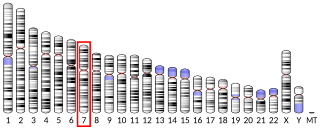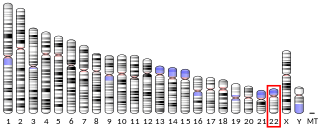
Caldesmon is a protein that in humans is encoded by the CALD1 gene.

Tropomyosin alpha-1 chain is a protein that in humans is encoded by the TPM1 gene. This gene is a member of the tropomyosin (Tm) family of highly conserved, widely distributed actin-binding proteins involved in the contractile system of striated and smooth muscles and the cytoskeleton of non-muscle cells.

Myosin-9 also known as myosin, heavy chain 9, non-muscle or non-muscle myosin heavy chain IIa (NMMHC-IIA) is a protein which in humans is encoded by the MYH9 gene.

Protein phosphatase 1 regulatory subunit 12A is an enzyme that in humans is encoded by the PPP1R12A gene.

Myosin-10 also known as myosin heavy chain 10 or non-muscle myosin IIB (NM-IIB) is a protein that in humans is encoded by the MYH10 gene. Non-muscle myosins are expressed in a wide variety of tissues, but NM-IIB is the only non-muscle myosin II isoform expressed in cardiac muscle, where it localizes to adherens junctions within intercalated discs. NM-IIB is essential for normal development of cardiac muscle and for integrity of intercalated discs. Mutations in MYH10 have been identified in patients with left atrial enlargement.

Myosin-11 is a protein that in humans is encoded by the MYH11 gene.

Myosin heavy chain, α isoform (MHC-α) is a protein that in humans is encoded by the MYH6 gene. This isoform is distinct from the ventricular/slow myosin heavy chain isoform, MYH7, referred to as MHC-β. MHC-α isoform is expressed predominantly in human cardiac atria, exhibiting only minor expression in human cardiac ventricles. It is the major protein comprising the cardiac muscle thick filament, and functions in cardiac muscle contraction. Mutations in MYH6 have been associated with late-onset hypertrophic cardiomyopathy, atrial septal defects and sick sinus syndrome.

Myosin essential light chain (ELC), ventricular/cardiac isoform is a protein that in humans is encoded by the MYL3 gene. This cardiac ventricular/slow skeletal ELC isoform is distinct from that expressed in fast skeletal muscle (MYL1) and cardiac atrial muscle (MYL4). Ventricular ELC is part of the myosin molecule and is important in modulating cardiac muscle contraction.

Myosin-2 is a protein that in humans is encoded by the MYH2 gene.

Myosin-1, also known as 'striated muscle myosin heavy chain 1', is a protein that in humans is encoded by the MYH1 gene. This gene is most highly expressed in fast type IIX/D muscle fibres of vertebrates and encodes a protein found uniquely in striated muscle; it is a class II myosin with a long coiled coil tail that dimerizes and should not be confused with 'Myosin 1' encoded by the MYO1 family of genes (MYO1A-MYO1H). Class I MYO1 genes function in many cell types throughout biology and are single-headed membrane-binding myosins that lack a long coiled coil tail.

Myosin-14 is a protein that in humans is encoded by the MYH14 gene.

Myosin light chain 3, skeletal muscle isoform is a protein that in humans is encoded by the MYL1 gene.

Protein phosphatase 1 regulatory subunit 12B is an enzyme that in humans is encoded by the PPP1R12B gene.

Striated muscle preferentially expressed protein kinase, in the human is encoded by the SPEG gene, a member of the myosin light chain kinase protein family. SPEG is involved in the development of the muscle cell cytoskeleton, and the expression of this gene has important roles in the development of skeletal muscles, and their maintenance and function. Mutations are associated with centronuclear myopathies a group of congenital disorders where the cell nuclei are abnormally centrally placed.

Myosin light polypeptide 6 is a protein that in humans is encoded by the MYL6 gene.

Myosin-8 is a protein that in humans is encoded by the MYH8 gene.

Myosin light chain kinase, smooth muscle also known as kinase-related protein (KRP) or telokin is an enzyme that in humans is encoded by the MYLK gene.

Myosin light chain 6B is a protein that in humans is encoded by the MYL6B gene. Myosin is a hexameric ATPase cellular motor protein. It is composed of two heavy chains, two nonphosphorylatable alkali light chains, and two phosphorylatable regulatory light chains. This gene encodes a myosin alkali light chain expressed in both slow-twitch skeletal muscle and in nonmuscle tissue.

Myosin-4 also known as myosin, heavy chain 4 is a protein which in humans is encoded by the MYH4 gene.
Myosin, light chain 12B, regulatory is a protein that in humans is encoded by the MYL12B gene. The gene is also known as MLC-B and MRLC2. The activity of nonmuscle myosin II is regulated by phosphorylation of a regulatory light chain, such as MYL12B. This phosphorylation results in higher ATPase activity and the assembly of myosin II filaments.




















